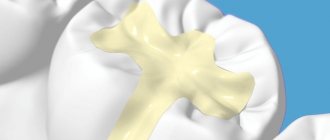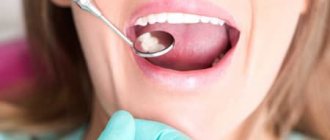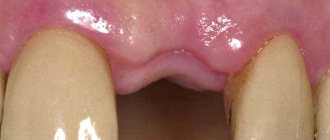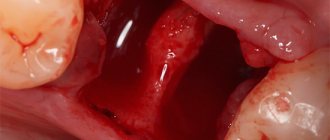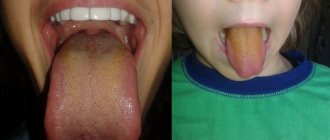Why is there a ban on food?
Temporary and permanent fillings are made from durable dental materials, most often powder combined with liquid. When mixed, the result is an elastic but tight consistency. To thicken it, a certain period of time is required, designed for the filling process.
During this period, the dentist places the material into the tooth, it hardens slightly, after which you cannot eat immediately. Now the doctor begins to grind and give the tooth relative evenness, comfortable for chewing. After the correct procedures, a person will eat without discomfort and other unpleasant sensations (incorrect work by the doctor sometimes leads to the fact that the teeth do not meet, creating the sensation of a foreign body).
Polymer and light materials are fixed by exposure to ultraviolet radiation, after which it is impossible to change their position. You can only sand it.
During the process of filling teeth, the doctor achieves a slight hardening, while the inner part of the composition still remains relatively soft and can be damaged by hard parts of food. Therefore, the average time during which you cannot eat after installing the composition is approximately 2-3 hours. They are necessary for complete hardening of the substance.
If this rule is not followed, the material is exposed to food, loses its integrity and other properties, for example, the uniformity of the filling. A change in these indicators can lead to the loss of the most important characteristics of the filling, which is why you should absolutely not eat after the procedure.
The filling fell out - what to do?
If a filling spontaneously falls out before the date prescribed by the doctor, you should immediately contact your dentist for advice. Option two:
- the doctor will put a new temporary filling if the treatment cannot be completed;
- the doctor will reschedule the main appointment and install a permanent filling in place of the fallen one.
In any case, walking with an open cavity in the tooth is fraught with complications. Before visiting the dentist, rinse your mouth after eating and carefully monitor your oral hygiene.
Food after light filling
When installing a light seal, different types of materials are used. The doctor will tell you exactly when you can start eating. Usually this period of time does not exceed 40-60 minutes.
During the day, the doctor does not recommend eating foods with dyes, and smoking is also prohibited, otherwise the composition will lose its reflective properties.
Cement compositions
If cement agents are prescribed to eliminate defects (the doctor does not use ultraviolet light in this case), then you should not drink or eat for 2-4 hours. How long after the filling can you eat, the doctor will tell you. Usually, smoking, drinking liquids and foods, including tea and coffee drinks, are prohibited during the day.
After filling, you should not eat if there are wounds in your mouth (the anesthesia lasts for about 1-2 hours). You can identify them visually - using a mirror.
Dentists are increasingly using simple cement compositions, since they do not have sufficient strength and durability, and they cannot be eaten for too long after them.
A cement filling is different from tooth enamel and is difficult to polish, so doctors offer patients light mixtures. Basically, inexpensive cement compositions are used to treat primary molars in children.
Advantages and disadvantages
Each type of dental treatment material has both its positive and negative qualities. Ultimately, filling with both composites is reliable, but with some nuances. To find out, let's compare the pros and cons of a light filling and a regular (chemical) one.
Advantages:
- allows you not only to make it unnoticeable, but also to almost completely restore the tooth to its original appearance, even if less than 20% of it remains;
- long service life - about 5 years or more - depending on the general condition of the tooth and oral care in general;
- allows you to select a composite that best matches the natural tone of tooth enamel, which allows you to fill even the front teeth, in the so-called smile line, absolutely unnoticeably;
- Many people are interested in how long after a light filling can they eat? You can eat immediately after its installation, and this is another additional advantage of this method of treatment;
- filling with a reflective composite is easier than with a regular one - it is possible to quickly correct errors in the shape of the tooth or when applying the material.
Flaws:
- One of the disadvantages is the high cost of filling;
- If you had your teeth filled with this material, then the answer to the question: how long after a light filling can you eat coloring sounds like this: after a few hours at least, and better – after a couple of days.
Chemical
Advantages:
- thanks to the components of the material, it allows you to protect the tooth from repeated recurrence of caries;
- the component hardens more evenly than in a light filling; accordingly, they hold up well, rarely crumble, fall out or cause other inconveniences, but their service life is no more than 3 years.
- Tooth filling should be performed very quickly, since the material hardens almost instantly - a certain skill or extensive experience in working with such material is required;
- It is not always possible to fill a tooth accurately; moreover, it is difficult to replicate the natural shape of the tooth with such material - for the first time after filling, the patient feels uncomfortable closing his teeth and chewing.
Read also: Pain-relieving gels for teething in children
As you can see, both filling methods have many positive aspects and very few disadvantages. What is the difference then, you ask? Everything is very simple. The difference is the cost.
Thus, you see that both materials are suitable for filling teeth - each in its own situation and for certain teeth.
Of course, if the front teeth are filled, the tooth decay is minor, and the inflammatory process is minimal, then it is best to use a reflective composite during work. This will make the filling invisible, as well as preserve the aesthetic beauty of the tooth as a whole.
The only question that remains is whether it is possible to eat after a light filling and when it is possible to eat such foods as coffee drinks, chocolates, borscht with beets and other colorings after a light filling.
Let's look at it in more detail to fully understand the properties of the reflective composite and its features.
Why does a tooth hurt after filling and what to do about it? Such a symptom can be either a normal reaction to mechanical stress or a serious cause for alarm.
Unfortunately, many people put off going to the dentist until “endless tomorrows” because they are afraid of the drill. And there’s nothing to be afraid of. Read the material yourself about whether caries is painful to treat, and don’t put off visiting the dentist.
Plastic
Plastic has almost ceased to be used in dental fillings, but it is found occasionally. Therefore, the information on how many hours you should not eat after treatment is still relevant:
- doctors recommend not drinking for 2 hours;
- You can’t eat for at least 5 hours.
As with any other material, once the plastic element is installed, you should not eat while the anesthesia is in effect. This is due to an increased risk of injury - you can bite the mucous membrane and not notice.
Treatment with light composites
Treatment of medium and deep caries, periodontitis and pulpitis in most cases is carried out under local anesthesia.
Modern anesthetics: The drugs are produced in the form of long capsules - carpules, which are inserted into a dental syringe. An individual needle and ampoules will protect a person’s health from infections that spread through the blood.
Anesthetics have a pronounced effect and reliably suppress pain sensitivity. All remaining manipulations are carried out completely painlessly. The effect of the drug varies from 30 minutes to 2–4 hours. If a person has chronic diseases or is prone to allergic reactions, this should be reported to the doctor. When choosing pain relief, be sure to take into account the presence of pregnancy, breastfeeding and the early age of the patient.
Before installing the composite, the doctor removes tissues affected by caries, cleans the cavity, and carries out antiseptic treatment. The restoration of the tooth crown is carried out gradually. When treating moderate caries, in order to avoid complications, a therapeutic pad is placed on the bottom. The material is introduced into the cavity layer by layer and illuminated with a special ultraviolet lamp. Upon completion of the work, the dentist adjusts the filling to the person’s bite, grinds and polishes it.
- Poor drying of the cavity during installation, development of secondary caries.
- Violation of the rules of oral care.
- Eating very hard foods: ice cubes, bones, nuts.
- Facial injury due to a fall, accident or blow.
- The restoration of the units was carried out with low-quality or expired mass.
Read also: How long does dental anesthesia last?
If the photocomposite falls out of the cavity soon after treatment, do not delay visiting the doctor. Re-installation of the composite is carried out free of charge under warranty service.
Some people do not go to the doctor and walk around with a hole in their tooth. The situation is not accompanied by pain, but aesthetics and the act of eating are disrupted. The tissues are quickly destroyed, and subsequently an inflammatory process occurs at the tops of the roots. As a result, the once healthy unit has to be removed, due to the fault of the patient himself.
Metal parts
Gold and other metal alloys require painstaking work, which takes from 1 hour to several days (2-4 sessions). Gold does not corrode, has incredible strength, and the tooth is not destroyed when a filling is used.
The service life of the metal part is at least 10 years. How long should you not eat after filling a tooth with gold or other metals? Depends on the stage of the process, but usually at least 2 hours.
Is it possible to drink carbonated or foamy drinks after dental treatment?
Gas is a constant irritant to the tooth, and foamy drinks (for example, kvass) contain yeast, which can get into the wound and cause discomfort. In addition, in the first days after tooth extraction, it is not recommended to drink drinks from straws. When sucking any drink, a vacuum is created in the mouth, which can tear a blood clot out of the hole.
Temporary filling
Severe dental cases, such as pulpitis, require 2-3 sessions to restore teeth. In this case, temporary filling technology is used. It stops the inflammatory processes, and after a while it is replaced with a permanent one. Temporary materials are fragile and prone to cracking, but after installation of such a part you cannot eat for at least 3 hours.
Regardless of the type of filling, remember that during the first 3-4 days the material is sensitive to any coloring components.
This means that you need to give up not only soda and refined store-bought sweets with added dyes. This also includes: black tea, coffee of any kind, beets and carrots, berries, wine, any sauces.
It is not recommended to eat foods with increased hardness during this time: nuts, apples, crackers and seeds.
How long should you abstain from food?
The ban on food is due to the way the material hardens. All fillings, with the exception of photopolymer ones, are set only from above in the first minutes. The process of complete hardening lasts from several hours to a day.
Important! If you eat immediately after treatment, mechanical and chemical influences cause the material to shrink, wash out, and become stained. Although outwardly the filling may appear solid.
The ban on food is due to the way the material hardens.
The dentist must warn the patient how long to abstain from food. The time varies depending on the material used and filling technology.
Fillings made of metal alloys (gold, silver) are practically not used today due to high toxicity and low aesthetics. They are used only in budget clinics.
After installation of amalgam, you should refrain from eating food, drinks, brushing your teeth, rinsing, or chewing gum for 3 hours.
Plastic
Also almost never used. Plastic is easily painted, deformed, and lasts no more than 2–3 years. It contributes to the development of complications in 90% of cases: secondary caries and pulpitis occur.
You can take any food no earlier than after 3 hours, preferably after 5.
Most often, composite fillings are installed.
Cement fillings are still widely used in dentistry due to their low cost, durability, and lack of side effects. Their strength is higher than amalgam and plastic, but lower than that of composites.
Additional Information ! The service life of cement fillings is up to 5 years. But they often fall out after 2–3 years. Modern glass ionomer (GIC) substances are most often used.
Drinking and eating after installation of cement filling materials is allowed after 2 - 3 hours; for GIC, the time is reduced to 1 hour.
Composites are the most popular in modern dentistry. They allow you to completely replicate the color and shape of the tooth, last 5–10 years, and are slightly susceptible to staining and chipping.
The time of abstinence from food after the installation of composites depends on the method of their curing:
- for photo-curables - allowed to eat immediately;
- for chemical curing - at least an hour after the procedure.
Temporary fillings are placed during multi-stage treatment, when access to the tooth cavity may be required after several days or weeks. They are less stable, their main task is to prevent the entry of foreign substances and leaching of drugs.
The abstinence time depends on the type of filling material:
- 2 – 3 hours for a release form based on cement or artificial dentin;
- If the cavity is closed with photopolymer, you can eat right away.
Read also: After caries treatment, tooth reacts to cold
Avoid eating solid foods for a couple of days.
Important! All temporary materials are fragile. It is recommended to avoid hard, viscous, sticky, stringy foods.
Smoking and medications after filling
Patients know that they can’t eat for a while after a filling, but not everyone thinks about whether it’s possible to smoke and take medications after the procedure?
Nicotine interferes with the restoration of soft and hard tissues. Healing is slower, so doctors recommend not smoking after the filling treatment procedure for at least 1 day.
A similar rule applies to such groups of medications as: herbal lozenges and lozenges, sprays, syrups.
What happens if you start eating?
If the patient ignores the rule that prohibits eating immediately after filling, complications may arise:
- the worst thing is darkening, which can only be corrected with a new part;
- severe tumors of the gums and tissues;
- aching pain that goes away only 2-3 days after the dental procedure.
There are other side effects associated with violation of filling technology: poor grinding of the material, incorrect installation. In this case, wear accelerates and the mucous membrane is constantly injured.
The average time required for complete hardening of any composition is 2-3 hours. Ultra-modern materials significantly reduce this period, while outdated technologies increase it.


